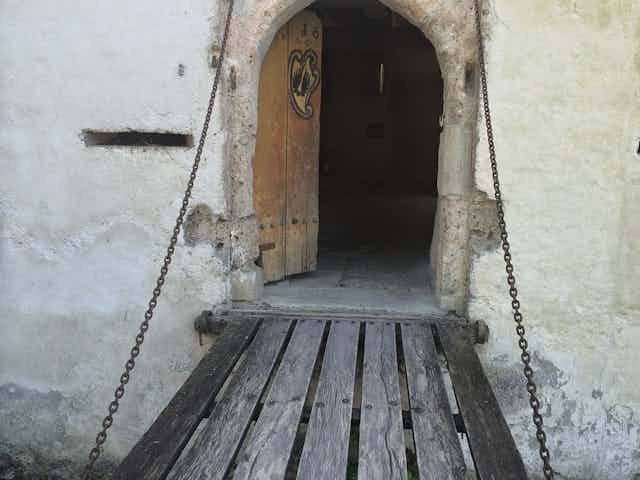This year, much interest is focused on what The Economist calls drawbridge politics.
Voters who believe in leaving the drawbridge down, so to speak, see opportunities in open borders for immigrants and trade. Voters who believe in pulling the drawbridge up see these as threats.

During the first presidential debate, on Sept. 26, Donald Trump said, “NAFTA is the worst trade deal, maybe ever signed anywhere.”
Free trade skeptics such as Trump and Bernie Sanders view imports from low-cost production countries as a menace to American jobs.
Isolationists, nationalists and ethnocentrists seek to protect the nation from immigrants, foreign dilution, terrorism and other threats, real or imagined. As my research shows, the relationship between party politics and these emerging issues is fraught with problems.
Global issues such as these are gaining importance, in contrast to the more familiar tax-and-spend issues. The fact that they cut across the traditional left-right political spectrum makes them unsettling. There are deep schisms within both the Democratic and Republican parties on issues of migration, and especially trade. This shift is making it harder for voters to know which political party will best represent their views.
Big tent parties
Popular sentiments against immigrants and imports can easily be fueled by the democratic process. Politicians have strong incentives to play on the fears of voters and blame external forces such as trading partners and immigrants for the perceived vulnerability of the nation.
This “democratic nationalism” is fanned by a vigorous media intent on exploiting voter fears. While democratic nationalism affects many Western countries, it seems to be especially prominent in the U.S. Why is that so?
A clue is in the party system.
The U.S. has had “big tent” or “catch-all” political parties for much of its existence. They are two broad mainstream parties, each capturing a wide variety of opinion on all kinds of issues. Big tent parties had an easier time consolidating views among their members and producing unified platforms during the 20th century, when the focus was on domestic questions of social welfare and redistribution versus deregulation and market freedoms.
However, when the issues shift to drawbridge topics like immigration and trade, the parties are less stable. Like a sticky weathervane, they are buffeted by crosswinds in which party members who are poles apart cannot unite behind a single policy. Within the Democratic Party, the left of the party is opposed to free trade because of the effect on workers. Within the Republican Party, the right is opposed to immigration because of the effect on national security, jobs and public services. For different reasons, both of these groups want the drawbridge up.
In the center are drawbridge-down politicians across both parties. On the Democratic side, they include President Obama and Hillary Clinton, prior to the current campaign. On the Republican side, they include most members of Congress, who voted in overwhelming numbers in favor of the many trade agreements the U.S. has signed since 2001. On questions of trade, drawbridge-down politicians - across both parties - have more in common with each other than with anti-free trade members of their own party.
Effects of global issues
Fear of trade and immigration affects big tent parties in at least three ways.
First, politicians who believe in pulling the drawbridge up run for office in big tent parties because they have little chance of being elected if they run in small nonmainstream parties. For example, in the 2014 elections for the U.S. House of Representatives, small parties gained upwards of 20 percent of the votes in some districts. Yet, they ended up with zero seats. If you actually want to be elected to Congress, your chances are better if you run as Republican or Democrat, whatever your views on immigration and trade.
Second, because big tent parties contain politicians with a wide variety of ideological positions on trade and migration, debate within the parties is a lot more polarized than it would be otherwise. Highly divergent opinion is destabilizing because it makes the process of forming policy on international issues more difficult.
Third, there is a lot of leeway for candidates to change positions during the course of campaigns without renouncing party affiliation, as Hillary Clinton has done on the Trans-Pacific Partnership trade deal. Sensing a shift in public opinion, her instincts led her to reject TPP.
Drawbridge politics in Europe
Like the U.S., we can see the impact of political parties on drawbridge politics in the United Kingdom, which also has a two-party system with the Labour and Conservative parties. In my 2004 book on U.K. policy toward the European Union, I showed how the two main parties contain politicians with highly divergent positions on European integration, and how that creates headaches for party leaders.
The most recent example is David Cameron. The EU was blamed for high levels of immigration in the U.K., which anti-immigrant politicians exploited. Many of these anti-immigrant politicians are members of the Conservative Party, precisely because of the electoral incentives mentioned above. In an effort to settle the question of British membership of the EU, he put the issue to a referendum. Several prominent members of his own party, notably Boris Johnson and Michael Gove, campaigned to leave, despite his own position that Britain should remain a member.
The U.K., like the U.S., struggles with the politics of immigration and trade in part because its big-tent parties are themselves so divided and polarized. Back home in the U.S., as issues of immigration and trade become more relevant to national debate, big tent parties will increasingly contribute to confusion and polarization among voters.

